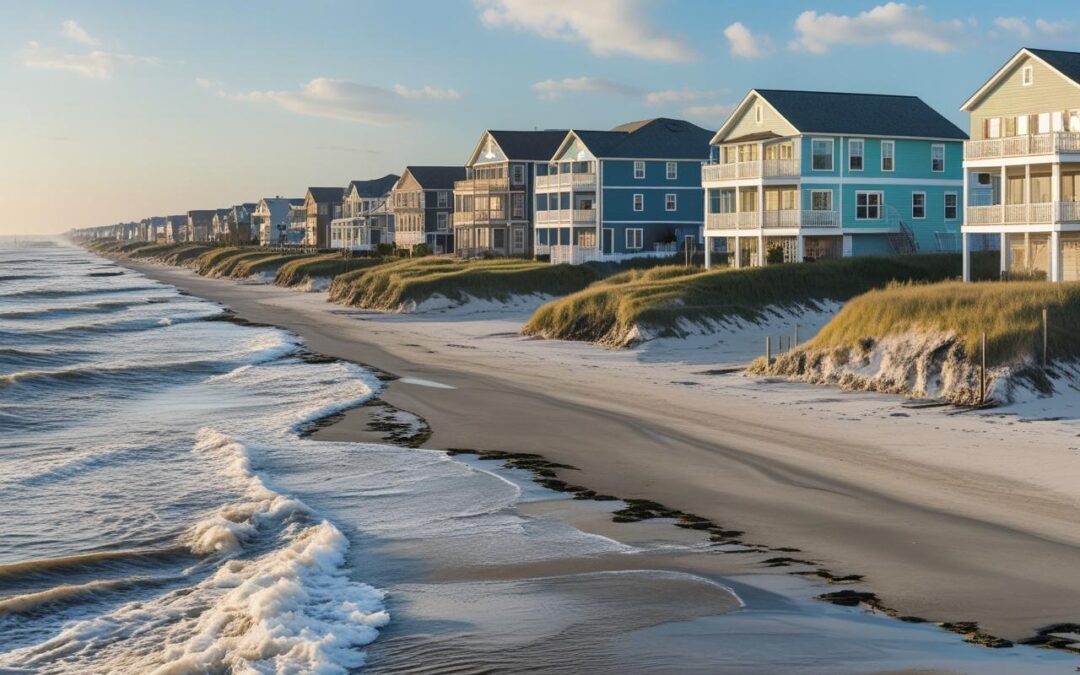
by support | Aug 2, 2025 | Blogs
The United States is home to some of the most beautiful and expensive coastal real estate in the world — from Florida’s sunny beaches to California’s Pacific shores. But in recent years, climate change has started to rewrite the rulebook for coastal property ownership. Rising sea levels, stronger storms, and unpredictable weather patterns are not just environmental issues anymore — they’re financial and personal ones too.
How Climate Change is Impacting Coastal Properties
Rising Sea Levels
Global warming is causing glaciers and polar ice caps to melt, leading to a steady rise in sea levels. This means many coastal properties in states like Florida, Louisiana, and New Jersey are now facing higher flood risks than ever before.
Stronger Hurricanes & Storm Surges
Warmer ocean temperatures give storms more power, leading to hurricanes with stronger winds and heavier rainfall. These extreme weather events can damage homes, erode shorelines, and increase insurance costs.
Erosion of Shorelines
Coastal erosion is a slow but steady threat. Over time, beaches and cliffs wear away, sometimes taking valuable land (and even buildings) with them.
Financial Risks for Homeowners
Declining Property Values – Buyers are becoming cautious about investing in high-risk coastal zones, which can lower resale values.
Rising Insurance Premiums – Flood and hurricane coverage is getting more expensive — and in some areas, harder to get.
Maintenance & Protection Costs – Sea walls, elevated foundations, and flood-proofing measures all require significant investment.
How Homeowners Can Protect Their Coastal Property
Understand Your Flood Zone – Check FEMA flood maps to know your property’s risk level.
Invest in Resilient Building Design – Elevated structures, hurricane-resistant windows, and waterproof materials can reduce damage.
Consider Climate-Proof Landscaping – Use plants and designs that help absorb water and reduce erosion.
Stay Informed About Local Policies – Some states offer grants or tax breaks for climate adaptation projects.
The Human Side of Coastal Living in a Changing Climate
For many Americans, living by the coast is more than just a lifestyle — it’s a dream. The sound of the waves, ocean sunsets, and fresh sea breeze are priceless experiences. But as climate change accelerates, that dream comes with new responsibilities.
It’s no longer just about buying a beautiful home — it’s about planning for the future, protecting your investment, and making choices that help the environment. Whether that means upgrading your property for resilience or supporting community climate initiatives, every action counts.
Final Thoughts
Climate change isn’t a distant problem anymore — it’s already shaping the future of the USA’s coastal real estate market. Homeowners who take proactive steps now will not only protect their properties but also help preserve the beauty of America’s shorelines for generations to come.
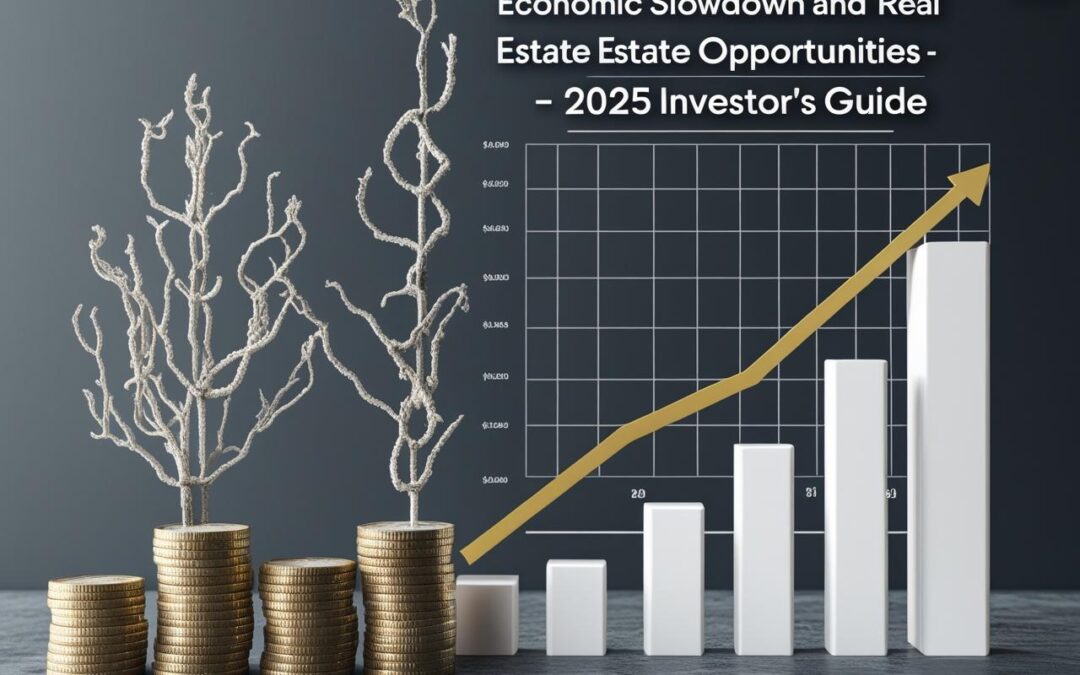
by support | Aug 2, 2025 | Blogs
Economic slowdowns often bring uncertainty, fear, and hesitation to the real estate market. But here’s the truth most beginners miss – challenging times can also be golden opportunities for smart investors. While others pull back, those who understand market cycles often position themselves for long-term success.
In this guide, we’ll explore how an economic slowdown can actually open new doors in the real estate market and how you can use this phase to your advantage.
1. Why Economic Slowdowns Create Real Estate Opportunities
When the economy slows down, people tend to be more cautious with buying property. This often leads to:
Lower property prices due to reduced demand
Motivated sellers willing to negotiate
Favorable mortgage rates (in some cases, as governments cut interest rates to boost activity)
For investors, this is the moment when quality properties can be purchased at a discount.
2. Types of Opportunities in a Slowdown
a) Distressed Properties
Owners struggling to meet mortgage payments may sell below market value. These properties, with some renovation, can generate strong returns.
b) Rental Market Growth
When buying slows, renting increases. Investing in rental units during a slowdown can mean steady income while property prices recover.
c) Commercial Space Conversions
Vacant office spaces or shops can be transformed into residential units, co-working spaces, or storage facilities, depending on market needs.
3. Smart Strategies for Investing During a Slowdown
Do Thorough Research – Focus on areas with strong long-term growth potential.
Negotiate Hard – Sellers may accept offers well below asking prices.
Diversify – Mix residential, rental, and commercial investments for balance.
Think Long-Term – Don’t expect overnight profits. Economic recoveries take time.
4. Risks to Consider
While opportunities exist, investors should stay cautious:
Slower property appreciation
Potential rental vacancies in some areas
Possible tighter lending conditions
Mitigate these risks with careful planning and by maintaining an emergency fund.
5. Human Insight – Why Patience Pays
Many successful investors say their biggest wins came from buying when others were selling. Economic slowdowns test your patience, but if you focus on quality deals and long-term potential, the rewards can be significant.
Final Thoughts:
Economic downturns are not the end of opportunities – they are simply a shift in the game. By staying informed, thinking strategically, and acting decisively, you can turn a slowdown into your advantage.
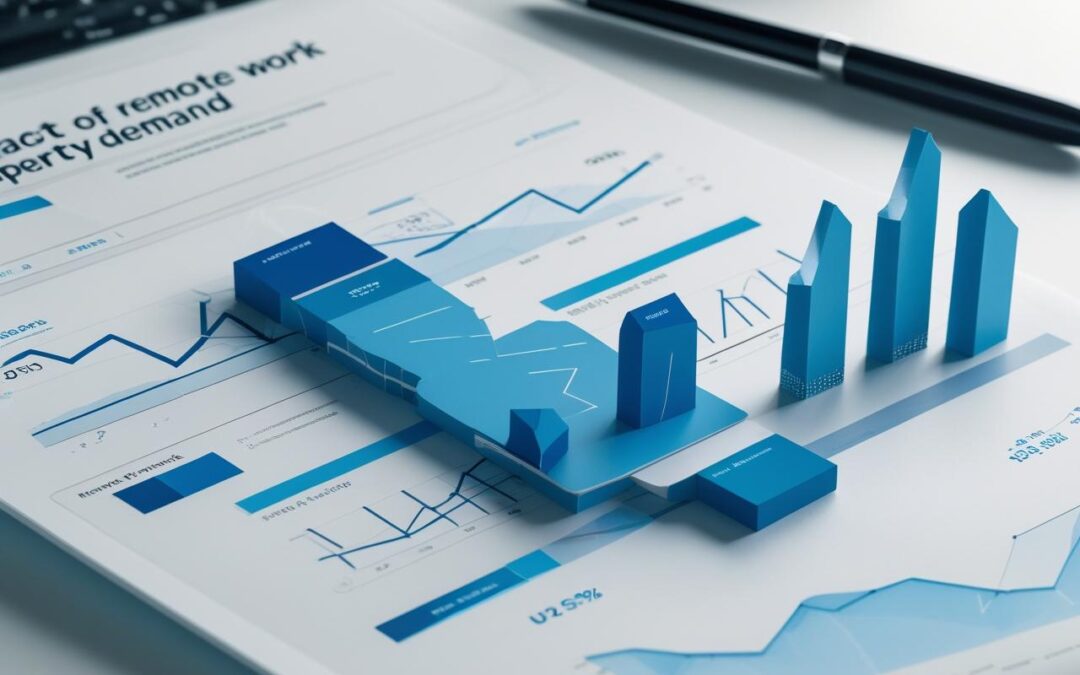
by support | Aug 2, 2025 | Blogs
In the past few years, remote work has transformed from a temporary pandemic solution into a permanent lifestyle for millions of Americans. This shift has not only changed daily routines but has also reshaped the USA property market in significant ways.
1. Moving Away from Big Cities
Before remote work became common, living close to offices in major metropolitan areas was a priority. High-rise apartments in cities like New York, San Francisco, and Chicago were in high demand. But now, many professionals no longer need to commute daily. This freedom is driving people toward suburban and rural areas where homes are larger, greener, and more affordable.
2. Bigger Homes for Better Workspaces
Remote workers are looking for properties with extra rooms or dedicated office spaces. A spare bedroom, a finished basement, or even a converted attic can now be a major selling point. Open floor plans are still popular, but privacy for video calls and meetings has become equally important.
3. Rising Demand in Secondary Markets
Cities like Austin, Boise, Raleigh, and Nashville are seeing rapid growth because they offer lower costs of living and a high quality of life. Buyers are choosing these locations over expensive coastal cities while still enjoying good internet connectivity and urban amenities.
4. The Role of Technology in Home Buying
Remote work goes hand in hand with remote home buying. Virtual tours, 3D walkthroughs, and online mortgage applications are making it easier for buyers to purchase property without ever stepping inside before closing. This digital transformation is widening the buyer pool and speeding up transactions.
5. Long-Term Impact on Real Estate Prices
As more people relocate to smaller cities and rural towns, property values in those areas are climbing. While this is great for current homeowners, it can make affordability a challenge for local residents. Meanwhile, some high-priced urban markets are experiencing slower growth or even slight declines.
Final Thoughts
The remote work revolution has made location more flexible than ever before. For real estate investors, agents, and buyers, understanding this trend is crucial to making smart property decisions in 2025 and beyond. Whether you’re seeking a spacious suburban home or a quiet countryside retreat, the shift toward flexible work is reshaping the American housing dream.
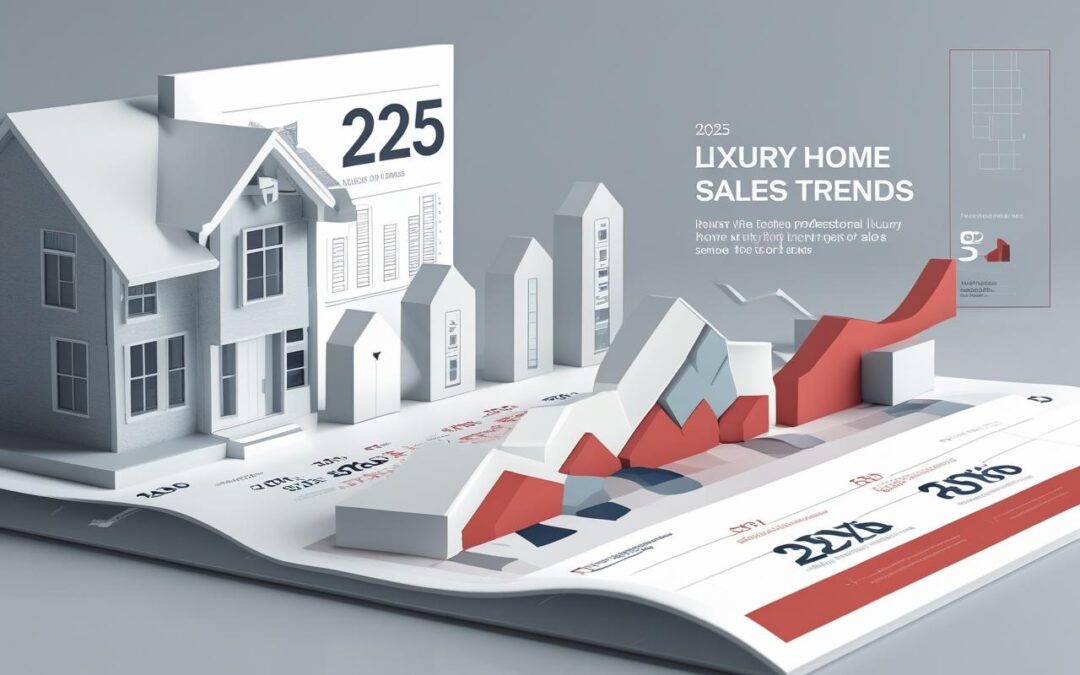
by support | Aug 2, 2025 | Blogs
The U.S. luxury real estate market in 2025 is redefining what “high-end living” means. With changing buyer priorities, evolving design trends, and strong demand from both domestic and international investors, luxury homes are no longer just about size—they’re about lifestyle, sustainability, and exclusivity.
1. Demand for Sustainable Luxury
We’re seeing a major shift toward eco-friendly luxury homes. Buyers in 2025 want energy-efficient designs, solar-powered systems, and smart home technologies that reduce their carbon footprint—without compromising on elegance. Properties featuring LEED certification and renewable energy setups are commanding premium prices.
2. Location is More Lifestyle-Focused
While prime neighborhoods like Beverly Hills, Palm Beach, and Manhattan remain hotspots, luxury buyers are now exploring lifestyle-rich cities such as Austin, Nashville, and Scottsdale. These locations offer privacy, cultural richness, and a balance between urban conveniences and nature.
3. Tech-Integrated Living
Smart home technology is no longer optional—it’s expected. From AI-powered security systems to climate-controlled wine cellars and app-controlled lighting, tech integration is enhancing convenience and security in luxury living.
4. Wellness and Health Amenities
Post-pandemic lifestyle changes have influenced luxury home designs. Spa-style bathrooms, in-house gyms, yoga studios, and even personal medical rooms are in demand. Wellness-focused architecture, with better air filtration and natural lighting, is a growing priority.
5. Investment-Driven Purchases
Many high-net-worth individuals are buying luxury properties as part of their investment portfolios. With U.S. property values expected to rise steadily through 2025, luxury homes in prime markets are being seen as both lifestyle assets and financial instruments.
6. International Buyers Making a Comeback
After a brief slowdown, international investors—especially from Asia, the Middle East, and Europe—are back in the U.S. market. The dollar’s stability, coupled with the prestige of owning property in America, continues to drive cross-border interest.
Final Thoughts
The luxury home sales trends in the USA for 2025 are shaped by innovation, lifestyle, and investment potential. Whether you’re a buyer, seller, or investor, staying informed about these shifts can help you make the most of opportunities in this competitive yet rewarding market.
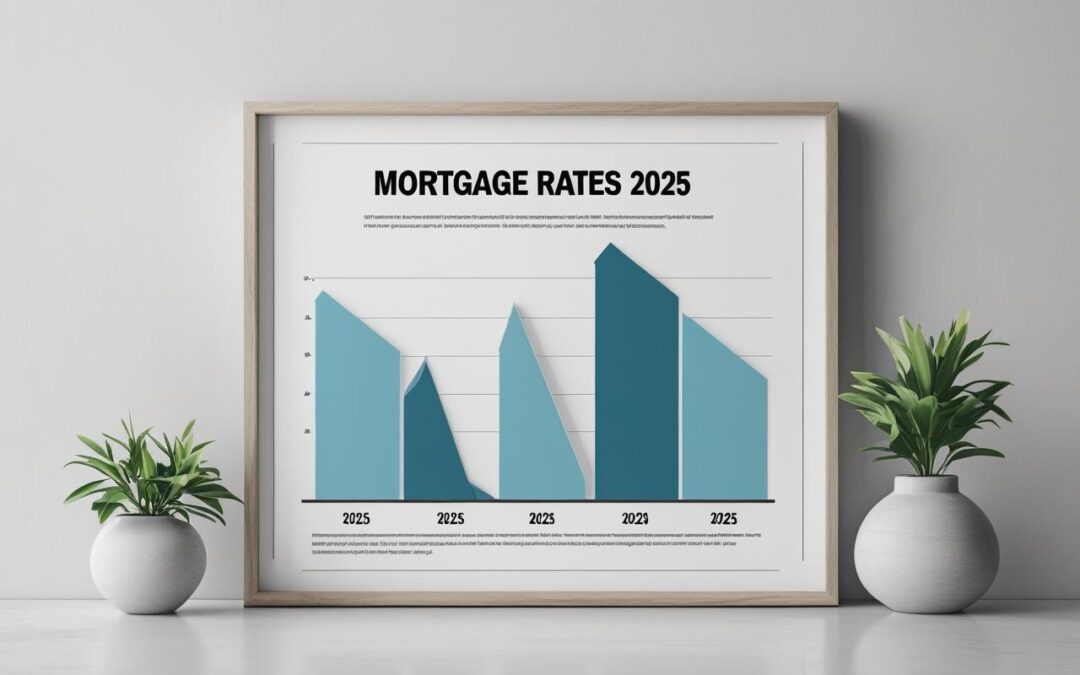
by support | Aug 2, 2025 | Blogs
Mortgage rates have always been a driving force in the housing market, and 2025 is no exception. Whether you’re a first-time buyer, a seasoned homeowner, or a real estate investor, understanding how interest rates will affect property prices and buyer behavior can make a big difference in your financial decisions.
Where Are Mortgage Rates Headed in 2025?
Experts predict that mortgage rates in 2025 will remain higher than the historically low rates we saw in 2020–2021, but slightly lower than the peaks of 2023–2024. Economic factors such as inflation control, Federal Reserve policies, and global market trends will play a major role.
If inflation continues to cool, we could see rates stabilize or even dip slightly in the second half of 2025, creating a potential window of opportunity for buyers.
Impact on Homebuyers
Affordability Challenges: Higher rates mean higher monthly payments, which can push some buyers out of the market.
Shift Toward Smaller Homes: Many buyers may opt for smaller or more affordable properties to keep payments manageable.
Increased Competition When Rates Drop: Any rate drop in 2025 could trigger a surge in buyer demand.
Impact on the Housing Market
Slower Price Growth: With borrowing costs higher, price growth may be moderate, giving buyers more negotiation power.
Longer Time on Market: Homes may take longer to sell, especially in higher price brackets.
Opportunities for Cash Buyers: Those who can avoid mortgages may find more bargaining power.
Tips for Buyers in 2025
Lock in Rates Early: If you find a good mortgage rate, consider locking it in before rates rise again.
Improve Your Credit Score: A higher score can mean a lower interest rate, saving you thousands.
Consider Adjustable-Rate Mortgages (ARMs): If you plan to sell or refinance within a few years, an ARM could be more affordable.
Negotiate Closing Costs: With a slower market, sellers may be more open to covering part of your expenses.
Final Thoughts
Mortgage rates in 2025 will directly shape the housing market, influencing everything from buyer demand to property values. While higher rates may slow the market, they can also create opportunities for strategic buyers who know how to navigate the changes.
If you’re planning to buy or invest in 2025, keep a close eye on mortgage trends, and be ready to act when the timing feels right.





